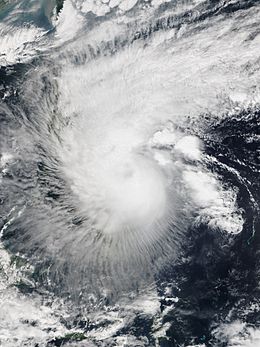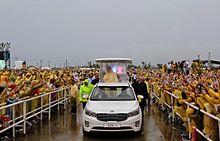Tropical Storm Mekkhala (2015)
| Severe tropical storm (JMA scale) | |
|---|---|
| Category 1 typhoon (SSHWS) | |
 Severe Tropical Storm Mekkhala making landfall over the Philippines on January 17 | |
| Formed | January 13, 2015 |
| Dissipated | January 21, 2015 |
| Highest winds | 10-minute sustained: 110 km/h (70 mph) 1-minute sustained: 130 km/h (80 mph) |
| Lowest pressure | 975 hPa (mbar); 28.79 inHg |
| Fatalities | 3 total |
| Damage | $7.8 million (2015 USD) |
| Areas affected | Caroline Islands, Philippines |
| Part of the 2015 Pacific typhoon season | |
Severe Tropical Storm Mekkhala,[nb 1] known in the Philippines as Tropical Storm Amang, was an early-season tropical cyclone that made landfall over the Philippines in January 2015. Mekkhala killed three people in the Bicol Region and caused light crop damage. Notably, the storm disturbed Pope Francis’ visit to the country. Although the storm also caused an airplane crash in Tacloban, nobody was hurt in the incident.
The system developed on January 13 between the Philippines and Guam. Moving west-northwest for its duration, Mekkhala passed north of Yap State on January 14 while slowly intensifying due to moderate wind shear. Conditions became more favorable on January 16, when the storm quickly strengthened to peak winds of at least 110 km/h (70 mph); a ragged eye prompted the American-based Joint Typhoon Warning Center (JTWC) to upgrade it to a typhoon. The storm weakened slightly and made landfall on the Philippine island of Samar on January 17. Mekkhala weakened further over land, dissipating on January 21 east of Luzon.
Meteorological history

Tropical storm (39–73 mph, 63–118 km/h)
Category 1 (74–95 mph, 119–153 km/h)
Category 2 (96–110 mph, 154–177 km/h)
Category 3 (111–129 mph, 178–208 km/h)
Category 4 (130–156 mph, 209–251 km/h)
Category 5 (≥157 mph, ≥252 km/h)
Unknown
A tropical disturbance formed approximately 390 km (240 miles) south-southwest of Pohnpei early on January 9.[2] The system remained disorganized until the Joint Typhoon Warning Center (JTWC) issued a Tropical Cyclone Formation Alert to it late on January 12, when deepened convection with formative started to wrap into a slowly-consolidating low-level circulation center (LLCC).[3][nb 2] Afterwards, the Japan Meteorological Agency (JMA) upgraded the low-pressure area to a tropical depression early on January 13,[nb 3] as did the JTWC with the designation 01W[6] Although deep convection was displaced to the northwest of an exposed LLCC early on January 14, the JMA still upgraded the system to a tropical storm and named it Mekkhala, under moderate vertical wind shear offset by excellent poleward outflow.[7][8] In post-season analysis, the agency upgraded the storm at 12:00 UTC on the previous day.[9] Late on January 14, the PAGASA named the storm Amang right after it entered the Philippine Area of Responsibility.[10]

Tracking west-northwestward and then westward along the southern periphery of a subtropical ridge, Mekkhala was upgraded to a tropical storm by the JTWC early on January 15, due to its slightly improved structure.[11] Mekkhala quickly intensified on the next day due to improved conditions; the wind shear became in-phase with the storm's motion while the robust divergent outflow persisted.[12] Therefore, the JMA upgraded the system to a severe tropical storm at 06:00 UTC on January 16,[9] and later that day the JTWC upgraded it to a typhoon, when a central dense overcast has significantly deepened and totally obscured the LLCC.[12] Later, a microwave imagery revealed that Mekkhala formed a ragged eyewall structure.[13] The system reached peak intensity at 00:00 UTC on January 17 with ten-minute maximum sustained winds of 110 km/h (70 mph),[9] although operationally the JMA estimated typhoon-force winds of 130 km/h (80 mph).[14]
After slightly weakening, Mekkhala tracked northwestward and made landfall over Dolores, Eastern Samar of the Philippines at around 15:00 Philippine Standard Time (07:00 UTC), where Typhoon Hagupit also made landfall the month before.[15] Both the JMA and the JTWC downgraded Mekkhala to a tropical storm on January 17, due to land interaction weakening the storm significantly.[16][17][18] Mekkhala eroded further while crossing the Bicol Region on January 18, leading the JTWC to downgrade it to a tropical depression when it turned northward and emerged into the Philippine Sea.[19] Late on the same day, the JMA downgraded Mekkhala to a tropical depression, and shortly after the JTWC issued the final warning as strong wind shear exposed the LLCC.[20] The tropical depression drifted northeastward and maintained its exposed low-level circulation east of Luzon, until the system was completely absorbed by a stationary front early on January 21.[21][22]
Impact

During January 14, Mekkhala passed about 95 km (60 mi)* to the north of Yap State and less than 45 km (30 mi)* to the south of the atoll Ulithi.[23] A peak wind gust of 58 km/h (36 mph) was recorded in Yap State, along with a rainfall total of around 13 mm (0.5 in).[23] On Ulithi a rainfall total of 100 mm (4 in) was recorded, while there were no reports of any deaths or significant damage on either Ulithi or in Yap State.[23]
Severe Tropical Storm Mekkhala, also known as Tropical Storm Amang, killed three people in the Bicol Region of the Philippines. Damage in the region amounted to ₱318.7 million (US$7.1 million), stemming mostly from agriculture.[24] In addition, the storm caused agricultural damage of ₱30.3 million (US$680,000) in Samar.[25] The crop damage and a subsequent drought caused rice shortages in the country, prompting the government to import the grain in May 2015.[26] Throughout the country, 48 homes were destroyed while a further 490 sustained damage.[25] Infrastructural losses reached ₱49.7 million (US$1.1 million); repairs to roadways was quick and completed by January 21.[24] A volunteer from the Bicol Region, who worked for a Catholic Relief Services station in Salcedo, Eastern Samar, was hit by a soundbox due to a collapsed scaffolding caused by heavy winds during a papal Mass held in Daniel Z. Romualdez Airport in Tacloban, Leyte.[27]
To comfort Tacloban people who suffered from the devastating disaster caused by Typhoon Haiyan in 2013, and Typhoon Hagupit a month prior, Pope Francis visited the storm-ravaged city on January 17. However, the schedule is significantly impacted by Severe Tropical Storm Mekkhala, making thousands of pilgrims and even Pope himself have to wear a raincoat during the rain-soaked Mass in the airport.[28] Only several minutes after Pope Francis’ own aircraft left the airport, a private jet was veered off the runway by strong winds of Mekkhala and eventually crashed. The 15 passengers on the plane were all safe, including many officials from the Cabinet of the Philippines.[29]
See also
Notes
- ^ The name Mekkhala was submitted to the World Meteorological Organization by Thailand and comes from the Thai angel of thunder Manimekhala (Template:Lang-th).[1]
- ^ The Joint Typhoon Warning Center is a joint United States Navy – United States Air Force task force that issues tropical cyclone warnings for the western Pacific Ocean and other regions.[4]
- ^ The Japan Meteorological Agency is the official Regional Specialized Meteorological Center for the western Pacific Ocean.[5]
References
- ^ "List of names for tropical cyclones adopted by the ESCAP/WMO Typhoon Committee for the western North Pacific and the South China Sea (valid as of 2015)". Japan Meteorological Agency. 2015. Archived from the original on March 24, 2015. Retrieved March 24, 2015.
- ^ "Index of /tcdat/tc15/WPAC/01W.MEKKHALA/ir/geo/1km". US Naval Research Laboratory, Marine Meteorology. Retrieved January 19, 2015.
- ^ "Tropical Cyclone Formation Alert". Joint Typhoon Warning Center. Archived from the original on January 19, 2015. Retrieved January 19, 2015.
- ^ "Joint Typhoon Warning Center Mission Statement". Joint Typhoon Warning Center. United States Navy. 2011. Archived from the original on July 26, 2007. Retrieved July 9, 2013.
- ^ "Annual Report on Activities of the RSMC Tokyo - Typhoon Center 2000" (PDF). Japan Meteorological Agency. February 2001. p. 3. Retrieved July 9, 2013.
- ^ "Prognostic Reasoning for Tropical Depression 01W (One) Warning Nr 01". Joint Typhoon Warning Center. Archived from the original on January 13, 2015. Retrieved January 19, 2015.
- ^ "RSMC Tropical Cyclone Advisory 140600". Japan Meteorological Agency. Archived from the original on January 14, 2015. Retrieved January 19, 2015.
- ^ "Prognostic Reasoning for Tropical Depression 01W (One) Warning Nr 04". Joint Typhoon Warning Center. Archived from the original on January 14, 2015. Retrieved January 19, 2015.
- ^ a b c RSMC Tokyo — Typhoon Center (February 17, 2015). Tropical Storm Mekkhala Best Track 2015-02-17T07:00:00Z (Report). Japan Meteorological Agency. Retrieved August 6, 2015.
{{cite report}}: Unknown parameter|deadurl=ignored (|url-status=suggested) (help) - ^ "Severe Weather Bulletin Number One". PAGASA. Archived from the original on January 15, 2015. Retrieved January 19, 2015.
- ^ "Prognostic Reasoning for Tropical Storm 01W (Mekkhala) Warning Nr 07". Joint Typhoon Warning Center. Archived from the original on January 15, 2015. Retrieved January 19, 2015.
- ^ a b "Prognostic Reasoning for Typhoon 01W (Mekkhala) Warning Nr 14". Joint Typhoon Warning Center. Archived from the original on January 17, 2015. Retrieved January 19, 2015.
- ^ "SSMIS Microwave Imagery of Typhoon 01W (Mekkhala) at 2223Z on January 16, 2015" (JPEG). US Naval Research Laboratory, Marine Meteorology. Retrieved January 19, 2015.
- ^ "RSMC Tropical Cyclone Advisory 170000". Japan Meteorological Agency. Archived from the original on January 17, 2015. Retrieved January 19, 2015.
- ^ "SitRep. No. 06 re Effects of Tropical Storm "AMANG" (MEKKHALA)". National Disaster Risk Reduction and Management Council. Archived from the original (PDF) on January 19, 2015. Retrieved January 19, 2015.
- ^ "RSMC Tropical Cyclone Advisory 171500". Japan Meteorological Agency. Archived from the original on January 18, 2015. Retrieved January 19, 2015.
- ^ "RSMC Tropical Cyclone Advisory 170900". Japan Meteorological Agency. Archived from the original on January 18, 2015. Retrieved January 19, 2015.
- ^ "Prognostic Reasoning for Tropical Storm 01W (Mekkhala) Warning Nr 17". Joint Typhoon Warning Center. Archived from the original on January 18, 2015. Retrieved January 19, 2015.
- ^ "Prognostic Reasoning for Tropical Depression 01W (Mekkhala) Warning Nr 21". Joint Typhoon Warning Center. Archived from the original on January 18, 2015. Retrieved January 19, 2015.
- ^ "Tropical Depression 01W (Mekkhala) Warning Nr 022A Amended and Relocated". Joint Typhoon Warning Center. Archived from the original on January 19, 2015. Retrieved January 19, 2015.
- ^ "Marine Weather Warning for GMDSS Metarea XI 2015-01-21T00:00:00Z". GISC Tokyo. Japan Meteorological Agency. Retrieved January 21, 2015.
- ^ "Marine Weather Warning for GMDSS Metarea XI 2015-01-21T06:00:00Z". GISC Tokyo. Japan Meteorological Agency. Retrieved January 21, 2015.
- ^ a b c Pacific El Nino-Southern Oscillation (ENSO) Applications Climate Center (May 29, 2015). "Pacific ENSO Update: 2nd Quarter 2015" (PDF). 21 (2).
{{cite journal}}: Cite journal requires|journal=(help) - ^ a b Mar S. Arguelles (January 21, 2015). "Storm 'Amang' leaves 3 people dead, P318.7M in damages in Bicol". Philippine News Agency. Interaksyon. Retrieved March 24, 2015.
- ^ a b "SitRep No. 10 re Effects of Tropical Storm "Amang" (MEKKHALA)". National Disaster Risk Reduction and Management Council. January 20, 2015. Archived from the original (PDF) on February 6, 2015. Retrieved January 23, 2015.
- ^ Alladin S. Diega (May 22, 2015). "El NiAo forces PHL to import more rice". The Business Mirror. – via Lexis Nexis (subscription required)
- ^ "Pope offers prayers for volunteer who died after Tacloban papal Mass". GMA News. Retrieved January 19, 2015.
- ^ Levine, Brittany (January 16, 2015). "New typhoon soaks Pope Francis' trip to storm-ravaged Philippine city". Mashable. Retrieved January 20, 2015.
- ^ Arcangel, Xianne (January 17, 2015). "They're all safe: Ochoa, Coloma on light plane that skidded in Tacloban". GMA News. Retrieved January 20, 2015.
External links
- JMA General Information of Severe Tropical Storm Mekkhala (1501) from Digital Typhoon
- JMA Best Track Data of Severe Tropical Storm Mekkhala (1501) Template:Ja icon
- 01W.MEKKHALA from the U.S. Naval Research Laboratory

